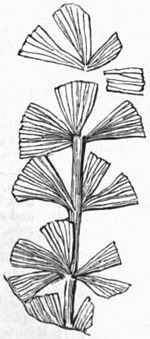tail). But they have the same enormous proportions in size as remarked for lepidodendron and sigillaria compared with club mosses. Their trunks vary from 1 to 6 in. in diameter, their length from 6 to 40 ft. They appear to have grown close together and in thickets, at least in some localities; for example, near Carbondale, Pa., such forests of calamites are seen petrified, standing and imbedded in sandstone, their trunks in close proximity to one another. The branches of calamites bear whorls of linear narrow leaves, which have been described as asterophyllites. Their fruits, Wolkmannia, are cones bearing seeds like those of species of equisetum, merely differing by the presence of scales and imbricated in rows. Two other genera, represented by branches bearing leaves also in whorls, appear referable to the same family of calamites, or perhaps to one intermediate between calamites and lepidodendron.

|

|
| Fig. 11.—Annularia longifolia. | Fig. 12.—Sphenophyllum Schlotheimii. |
One of these, annularia, bears linear, lanceolate, thickish, pointed leaflets, sometimes inflated and nearly cylindrical; it resembles asterophyllites in its facies; the other, sphenophyllum, has cuneate or flabellate leaflets, enlarging upward from the point of attachment.—It is now generally admitted that the formation of a bed of coal, and of the strata which separate it from the one above it, has demanded a long period of time, sufficient to modify somewhat the characters of the vegetation. It seems therefore that it might be easy to remark and point out the difference between the plants of two subsequent beds of coal. The miners in general appreciate this difference, and indeed it is usually an easy matter for a palæontologist to remark it when his observations are limited to the same locality. But the study is rendered very difficult by the variations in the distribution of the plants as remarked in the same bed at distant localities. The variability acting in two ways, horizontally and vertically, the result of its force in one way or the other can be appreciated only from long researches. In the coal fields of the United States, lepidodendron species predominate in the lower part of the true coal measures, and their remains have especially contributed to the formation of the big vein, B. They gradually disappear in passing up. The sigillaria species are more equally distributed from the base to the middle, while the ferns become more predominant in ascending, especially in small species. The calamites and ribbon-like flabellaria are about in the same proportion through the whole thickness of the carboniferous.—The peculiar distribution of trunks of fern trees in sandstone, which has been remarked upon already, may be taken for evidence in a question often discussed among palæontologists: Do the plant remains found in connection with the coal strata represent the whole flora of the carboniferous period? or was this flora, like that of our present peat bogs,
